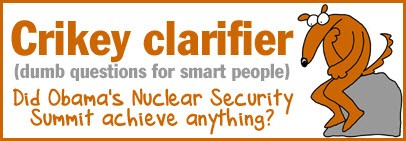World leaders converged on Washington last week for a two-day talkfest on nuclear security. They’ve agreed to prevent “non-state actors” from getting their hands on nuclear materials for malicious purposes. Does that mean we’re all safer from a nuclear attack now? Crikey spoke to Professor Richard Tanter, an international relations expert at RMIT University, to find out.
Has the summit been a success?
“Yes, in the sense that there’s never been a nuclear summit with so many world leaders before,” Professor Tanter said. “The really action-oriented summits have always been bilateral.”
It has also helped lay the groundwork for the next formal meeting on nuclear security, he added. This will be held in May and will focus on the Nuclear Non-Proliferation Treaty (NPT), a treaty that aims to limit the spread of nuclear weapons. Review Conferences are held every five years to review it. “The last one in 2005 was a disaster,” he said. “A schmozzle. Absolutely nothing happened.”
Is the world a safer place now?
“No, nothing was done at the summit that produced immediate results,” Tanter told Crikey.
There are benefits from the summit in the longer term, though. Over the next four years, there are plans to track down all the fissile materials, which are materials that could be used to make a nuclear weapon by a state or non-state actor. “We really don’t know where a lot of that material is, especially in the former Soviet Union,” he said.
“There was a real awareness that there is a problem about terrorists getting access or building a nuclear weapon,” he said. “Nuclear weapons already existing could fall into the hands of people who, in inverted commas, ‘we don’t like’,” he added. “The double standard is always there.”
Leaders have agreed to switch from producing highly enriched uranium to low enriched uranium. What’s the difference?
When uranium is mined, it’s in the form of yellowcake, and is then refined into uranium metal. Next it has to go through a process of uranium enrichment in order to generate a fission reaction. Weapons-grade uranium needs to be enriched about three times as much as reactor grade uranium. “It’s a much longer process,” Tanter explained.
There is a debate among scientists, though, and some think it may be possible to use low enriched uranium for a weapon. Even so, “highly enriched uranium is what most weapons builders are looking for”.
The US and Russia each have to dispose of 34 tonnes of excess plutonium. What will happen to it?
“The Americans have a good use for that,” he said. “Since the end of the Cold War a lot of American nuclear power stations have been fueled by plutonium warheads that are no longer wanted. That’s the most likely way it will be used.”
Kevin Rudd didn’t go to the summit; he sent Defence Minister John Faulkner in his place. Does that matter in terms of Australia’s international relations?
“In practical terms it didn’t matter,” Tanter said. “It’s not a scene where Australia was set to make a great play.”
Plus, Australia has been doing some work in the area of nuclear security. Last year, the Australian and Japanese governments co-chaired the Evans-Kawaguchi Commission, which was an international commission for nuclear non-proliferation and disarmament.
“The Japanese government was pressing very hard for Australia to recommend that the sole purpose of nuclear weapons be to deter the use of nuclear weapons,” he said. “Australia didn’t go along with that.”
How significant is it that North Korea and Iran didn’t attend?
“It’s always better to have antagonists in the room than not in the room,” said Tanter. “There’s no way that the North Koreans were going to come.
“In the case of Iran, what the Americans and Europeans are accusing Iran of, is while they’re a signatory to the NPT, they’re violating the rules of the NPT by secretly conducting enrichment of the nuclear material to a level you can use for a nuclear weapon.
“Obama was rallying support for stronger action on Iran and he was particularly looking at Russia and China. They’re not sure what to do about Iran. There’s some doubt about what’s happening there.”









It would seem that the world’s leaders are moving from prohibition to regulation, at last.
However, it would have to be a prohibitionist voice that says:
“There is a debate among scientists, though, and some think it may be possible to use low enriched uranium for a weapon. “
Such phrasing echoes of denialist talk, in that we are not told what sort of “scientist” made the speculation, or for that matter, what their motive was to say it.
However commonsense is enough to reassure readers. If it was possible to make bombs from low enriched uranium alone, why has everyone since the Manhattan project gone to the extreme bother of enriching it so much further?
Presumably because a low-enriched uranium bomb would be much larger and heavier than one using high-enriched uranium. Most atomic weapons are air or missile-delivered, meaning light weight and compactness is essential. I think they’re looking at the possibility of say an atomic truck bomb.
Another possibility is design difficulties. I assume that a low-enriched weapon would have to be an implosion type, but with a higher degree of implosion than current high-enriched ones. Which means that new design techniques would be necessary. Maybe that’s the real show-stopper.
Well yes, compression would reduce the geometric loss of neutrons during the rise by increasing the density of fissile nuclei, U235, while also increasing the density of absorber, U238. I suspect that the IAEA has set the division between “low enriched uranium” and “high enriched uranium” at the limit below which no critical mass can be achieved. But that sort of talk is porn for those who would frighten the ignorant.
It is not the job of environmentalists to worry about the possible activities of criminals. That is a police job, and international policing is possible if world-wide international agreements are put in place. I could point out that the IAEA did a pretty good job of detective work before the last Gulf War, with the agreements that were already in place.
We have a culture which helped kept the Cold War cold by maintaining public fear of a catalogue of horrible scenarios if we go nuclear. However the rate of decay of the greenhouse is already presenting us with an even worse catalogue of horrible scenarios if we don’t.
It is the use of hydrocarbons that is the more serious problem, and nuclear is part of the solution.
Roger,
It is well worth repeating what you so correctly stated, with a tiny addition.
“It is the use of hydrocarbons AND COAL that is the more serious problem, and nuclear is part of the solution.”